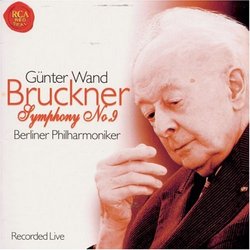| All Artists: Anton Bruckner, Günter Wand, Berlin Philharmonic Orchestra Title: Bruckner: Symphony No. 9 Members Wishing: 0 Total Copies: 0 Label: RCA Victor Europe Original Release Date: 1/1/1998 Re-Release Date: 8/12/1999 Album Type: Import, Live Genre: Classical Style: Symphonies Number of Discs: 1 SwapaCD Credits: 1 UPC: 743216324422 |
Search - Anton Bruckner, Günter Wand, Berlin Philharmonic Orchestra :: Bruckner: Symphony No. 9
 | Anton Bruckner, Günter Wand, Berlin Philharmonic Orchestra Bruckner: Symphony No. 9 Genre: Classical
|
Larger Image |
CD Details |
CD ReviewsA Symphony Unfinished Only in the Composer's Mind Grady Harp | Los Angeles, CA United States | 05/17/2003 (5 out of 5 stars) "Anton Bruckner's Symphony No. 9 is discussed more often than performed. Should the final two movements for which we have the composer's sketches be 'realised' and included in performance or is the final work of this Romantic giant complete as it stands? One listening to the majestic, spiritually uplifting symphony and the answer seems obvious: the symphony IS complete. Bruckner was one of the more misunderstood composers in history and much of that was due to the fact that he was an apparently simple organist, devoted to God, with a penchant for wooing young, poor maids, and a man so sensitive to criticism that he spent much of his life re-writing his symphonies in reaponse to 'suggestions' from his colleagues and critics, an attribute that labelled him an idiot savant composer well into the 20th Century. His symphonies are indelibly stamped with his personal language - episodic, frequent climaxes of such power that the sudden reversion to quiet pizzicato strains at the peak of his musical mountains can be jarring; his love and use of German landler that serve to ground his monuments to heaven with patches of the countryside of earth; his quotations from Wagner, etc. But well over a hundred years since his death his extraordinary gifts as a symphonist are held in awe and most orchestras have made his works a staple in their repertoire. All but the mighty 9th. Fortunately this magnum opus is gaining more frequent playings by important orchestras and conductors: Pierre Boulez just gave us his examination and majestic performance with the LA Philharmonic, revealing once again how this contemporary composer can reveal hidden secrets in the massively romantic symphonies. The recording here is by the Berlin Philharmonic conducted by Gunther Wand and is a joy in every way. The pacing of the symphony is astute, the joyful 2nd movement with all of its references to Bruckner's earlier symphonies is played with a magnificent range of sonics, and the intensely spiritual 3rd movement with all of the uses of the Dresden Amen melodies builds in awe-inspiring intensity like a heart bursting with longing and acceptance of life on earth ending. The symphony ends in a gentle exhale of stunned quiet, the release of the spirit from the corporeal body. This is a live performance thankfully free of any aural evidence of an audience, but imbued with the physical tension that only live recordings can completely embrace. The Berlin Philharmonic is up to its highest standards of playing and Wand lets the symphony breathe. Highly recommended."
|

 Track Listings (3) - Disc #1
Track Listings (3) - Disc #1